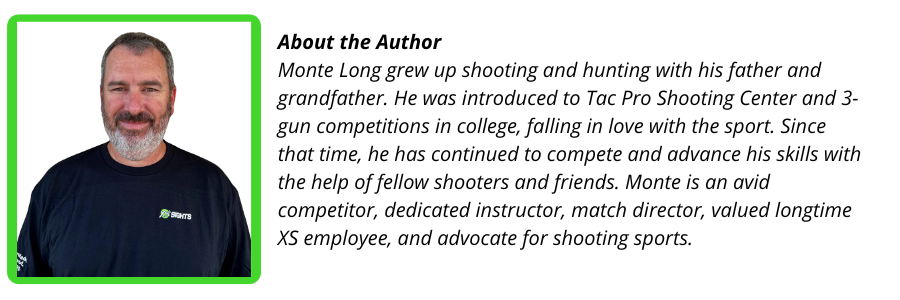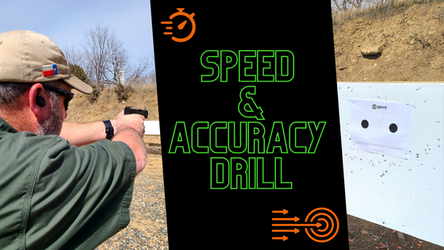Set Your Sights On This – Gila Hayes 5x5 drill
Posted by Monte Long on Jun 13th 2022
Okay folks, time for another drill! Today, we’ve got the 5X5 drill from Gila Hayes. Gila Hayes is a noted firearms instructor and author from the Pacific Northwest part of the country. Mrs. Hayes is an author, firearms instructor and has served as a reserve police officer. This drill was originally published in her book Personal Defense for Women: Practical Advice for Self Protection. It’s a drill that has been around for a while and has been used and/or modified by several instructors over the years. I know that both Claude Werner and Greg Ellifritz have both used it (or a modification of the 5X5) at various times.
Drill Standards
On the surface, it seems like a simple drill. Starting from the ready, on the go signal, put 5 rounds into a 5” circle at 5 yards. Easy, right? Well, not necessarily. My understanding is that several instructors have used the drill as a benchmark and have seen quite a few students struggle to pass the drill, especially if you use Claude’s “do it five times in a row” variation. It’s a good test of several of the fundamentals.
What does it take to perform the drill? You’ve got to break a shot, drive the gun back into the target, reset the trigger, and repeat. That means you’ll need an acceptable level of sight alignment, good trigger control, good follow through, and a good stance and grip to manage the recoil. Like I said, it’s a good way to test your application of several of the fundamentals. XS printable target for the Gila 5x5 drill.
Focus on the Fundamentals
So, what do you do if you can’t pass it? First thing is to determine why, and then start working on the areas that need improvement. If you’re struggling to meet the par time, is it because you’re having trouble managing the recoil? Or is it because you’re worried about the trigger press? If it’s recoil management, look at your stance and grip.
While I generally think stance is the least critical fundamental to accuracy, it plays a big role in your ability to make rapid ACCURATE follow-up shots. Get a good, athletic stance. Think about how you would set yourself up if you knew you were about to be in a fist fight. You’d want a good, stable base with your feet about shoulder width apart. For us right-handed folks, we’d likely have our strong fight slightly behind the left foot. That will allow us to throw a punch with our right hand and use our lower body to put some power into it. We’d probably have some bend in our knees. That bend will allow us to move a bit quicker to dodge an incoming punch, as well as allow us to roll with the punch a bit better if we can’t dodge it. We’d probably have a bit of lean towards the incoming threat to allow for a better center of gravity and to project a bit of aggression to an opponent. For the lefties in the crowd, it’s much the same, just drop the left food slightly rearwards rather than the right foot.
We want a good, firm grip on the handgun. A weak grip will allow for some weird movement as the gun recoils, and you’ll take more time settling the sights back on target. Make sure and get the strong hand high up on the gun and use the support hand to cover as much of the pistol’s grip as possible on the support side. During recoil, the pistol should track straight up and then straight back into the target.
If it’s the trigger press that’s giving you trouble, it’s time for some dry fire. When we press the trigger, we need to move it straight to the rear without disturbing the sights. Unfortunately, while it’s incredibly easy to say or type that, it’s considerably harder to accomplish. The simple solution is dry fire. If you’re working with a carry gun, work on dry fire a little every day until you can break the shot without moving the sights.
Practice Makes Perfect
The nice thing is that you really don’t need much to do that. Your unloaded carry gun and a blank wall is all you need. Clear the gun out, double check it, and then triple check it. Once you’re satisfied that the pistol is cleared, go ahead and check it again. Ideally, pick a wall that will have the greatest probability of stopping a bullet, just in case. Exterior walls on brick houses are a good choice. If you can, the corner of two exterior walls will be even better. Now, get a good sight picture, focus on the front sight, and press the trigger. Did you see the sights move? If you didn’t, then you had a good trigger press. If you had movement, keep working. Focus on pressing the trigger straight to the rear. If you see the sights start to move, stop the press, take a breath, and try again.
What about getting your rounds off in plenty of time, but you’re not keeping everything in the 5” circle? It could be a couple of things. It could be your trigger control needs some work (see the previous two paragraphs for some advice in that area). It could also be recoil management, or it could be timing. If you’re consistently hitting just high of the circle, it could be that you’re driving the gun just fine, but you’re trying to break the shot just a little too soon. Read the sights and wait for them to re-enter the 5” circle before you break the next shot.
If you’re consistently hitting low, then it’s likely to be because you’re trying to break the shot while the pistol is still moving, but you’re breaking the trigger a little bit late. It could also be that you’re trying to look over the sights to see where you hit. You will likely need to either get a video camera or have a friend watch you to isolate the two. If the problem is that you’re breaking the shot late, much like breaking the shot too early, let the gun settle in, make sure that the front sight is within the 5” circle before you break the shot.
If you find that you’re trying to look over the sights to see a hit, it’s a thought process issue. You want to see the impact. The fix is to spend some time shooting and learning to call your shots (look for a drill to do that at some point). Bottom line, wherever the front sight was when the slide started to move rearward, that’s where the bullet was going to hit, provided that your handgun is zeroed.
Successful? Make it More Challenging
So, for those that have gotten to the point where they can successfully complete the drill, what should you do? Make the drill more difficult, of course! If you’re consistently completing the drill from the ready, try working from your holster. You’re still testing the same fundamentals, but now you’re adding the draw stroke to the equation. If you’re consistently completing the drill from the draw, add your concealment garment. Still consistently completing the drill from a concealed draw? Well, increase the distance or decrease the time. While the drill is a baseline performance drill, don’t let your self get complacent. Modify it so that you continue to push yourself to improve.
Get out there, give it a try, and let us know what you think!

About XS Sights: XS Sights is known for making the fastest sights in any light. For more than 25 years, the XS team has created some of the most innovative sights on the market today for pistols, rifles, and shotguns. Whether used for personal defense or hunting, these sights are designed and built to be the absolute best for their specific purpose. American Made. Texas Proud. 2A Strong.

 CHRISTMAS COUNTDOWN: 20% off Everything | Order by 12/16 to Get it Before 12/25 | Discount Auto Applied at Checkout
CHRISTMAS COUNTDOWN: 20% off Everything | Order by 12/16 to Get it Before 12/25 | Discount Auto Applied at Checkout

